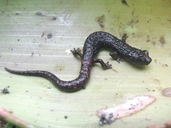|
Dendrotriton chujorum Campbell, Smith, Streicher, Acevedo & Brodie, 2010
| family: Plethodontidae subfamily: Hemidactyliinae genus: Dendrotriton |
| Species Description: Campbell JA, Smith EN, Streicher J, Acevedo ME, Brodie Jr ED 2010 New salamanders (Caudata: Plethodontidae) from Guatemala, with miscellaneous notes on known species. Misc Publ Mus Zoology Univ Mich 200: 1-66. | |
 © 2011 Carlos R. Vasquez-Almazan (1 of 3) |
|
|
|
Description DIAGNOSIS: Dendrotriton chujorum can be distinguish from other Dendrotriton species by its wide head, large feet, and short limbs. It is also one of the smaller species of Dendrotriton, but is not smaller than the D. cuchumatanus or D. sanctibarbus. Dendrotriton chujorum can be further differentiated from D. cuchumatanus by the former having smaller nostrils in adult males, larger feet, and smaller legs. Dendrotriton chujorum can further be differentiated from D. santibarbarus by the former having shorter limbs, smaller nostrils, and fewer number of maxillary-premaxillary teeth. Lastly, they can also be differentiated from D. rabbi due to D. chujorum having a smaller body size, wider head, larger feet, and larger nostrils in adult females (Campbell et al. 2010). COLORATION: In life, adult females have a rusty, red color in the dorsal parts of their body including the head, body, and tail. There is a noticeable pale and narrow interorbital bar. On the body, there is black mottling in the suprascapular and pelvic regions. The tail has irregular dark brown to black mottling scattered on the upper region. The underside of the throat is pale gray. From the gular fold to the tail’s ventrum is a dark gray-brown with a cluster of white stipples forming an irregular line in the ventrolateral regions. The vent is lightly pigmented. A mosaic of rusty and black mottling is located on the sides of the body and tail with heavy coverings of white stippling that increase ventrolaterally. The limbs’ upper surfaces have a rusty red coloration with minimal dark brown mottling and, like the throat, a gray color on the ventral surface. The hands and feet have primarily brown upper surfaces, but the surfaces of the palm and sole of feet are darker gray in color. Lastly, the iris is bronze colored with black reticulations (Campbell et al. 2010).In life, males have beige coloring in the dorsal surface of the head and body with dark brown mottling. The dorsal surface of the tail is dusty red. The ventral surfaces of the body and tail are purplish gray outlined with hefty white stippling on both sides that extends all the way to the tail. The chin is smoky gray but turns yellow at the throat. The lateral surfaces are dark brown with a yellow line extending along a glandular ridge. The limbs’ dorsal surfaces contain yellow and pale brown botches with pinkish-yellow ventral surfaces. The distal regions of the digits are dark brown (Campbell et al. 2010). When in preservative, the adult female dorsal surface is medium brown, and the pale glandular ridge that extends to the groin from the axilla takes on a yellowish color. The ventral surfaces and the sides of the body are dark, with the ventrum being darker than the sides of the body (Campbell et al. 2010). Preserved adult male heads and bodies have irregular, dark brown mottling. The sides of the body take on a cream-like color with irregular, dark brown blotches. Lastly, the ventral surfaces of the body, throat, and tail turn a pale color with tiny, black stippling (Campbell et al. 2010). The dorsal surface of a juvenile female in preservative is pale cream color with dark brown sides and a darker ventrum (Campbell et al. 2010). VARIATION: Males and female are sexually dimorphic by coloration and patterning. Females also have relatvely larger nostrils than males (Campbell et al. 2010).Distribution and Habitat Country distribution from AmphibiaWeb's database: Guatemala
Life History, Abundance, Activity, and Special Behaviors Larva Trends and Threats If Batrachochytrium salamandrivorans were to make it to Central America, D. chujorum may also be threatened with disease (IUCN 2020). Possible reasons for amphibian decline General habitat alteration and loss Comments ETYMOLOGY: The “chuj” part of D. chujorum’s name is derived from an ethnic and linguistic group of Mayans that occupy the locality the specimen was found. The “orum” part of the name is from a Lattin suffix “-orum”, which means “belonging to” (Campbell et al. 2010).
References
Campbell, J. A., Smith, E. N., Streicher, J., Acevedo, M. E., Brodie, E. D. Jr. (2010). "New salamanders (Caudata: Plethodontidae) from Guatemala, with miscellaneous notes on known species." Miscellaneous Publications Museum of Zoology University of Michigan, 200, 1-66. [link] Chan, L. M. 2003. Seasonality, Microhabitat and Cryptic Variation in Tropical Salamander Reproductive Cycles. Biological Journal of the Linnean Society 78.4: 489-496. IUCN SSC Amphibian Specialist Group. (2020). "Dendrotriton chujorum (amended version of 2020 assessment)." The IUCN Red List of Threatened Species 2020: e.T194310A176232851. https://dx.doi.org/10.2305/IUCN.UK.2020-3.RLTS.T194310A176232851.en. Downloaded on 17 February 2021. Originally submitted by: Perri Gish, Haruka Mukoyoma, Yunqi Luo (2021-08-19) Description by: Perri Gish, Haruka Mukoyoma, Yunqi Luo (updated 2021-08-19)
Distribution by: Perri Gish, Haruka Mukoyoma, Yunqi Luo (updated 2021-08-19)
Life history by: Perri Gish, Haruka Mukoyoma, Yunqi Luo (updated 2021-08-19)
Trends and threats by: Perri Gish, Haruka Mukoyoma, Yunqi Luo (updated 2021-08-19)
Comments by: Perri Gish, Haruka Mukoyoma, Yunqi Luo (updated 2021-08-19)
Edited by: Ann T. Chang, Michelle S. Koo (2023-07-22) Species Account Citation: AmphibiaWeb 2023 Dendrotriton chujorum <https://amphibiaweb.org/species/7573> University of California, Berkeley, CA, USA. Accessed May 5, 2025.
Feedback or comments about this page.
Citation: AmphibiaWeb. 2025. <https://amphibiaweb.org> University of California, Berkeley, CA, USA. Accessed 5 May 2025. AmphibiaWeb's policy on data use. |




 Raffaëlli Account
Raffaëlli Account Map of Life
Map of Life